Buying a Point and Shoot Camera
A Guide for the Perplexed by Philip Greenspun; created 1995
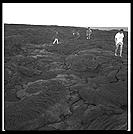
If you already own a P&S camera, you might enjoy
guide to taking good pictures
with a P&S camera.
Is a point and shoot camera the right tool for the job?
As I discuss in "Choosing a
Camera for a Long Trip", you have to decide whether the purpose
of an outing is primarily photographic. Are you trying to
experience Paris or photograph Paris? If you're going to be
spending 80% of your time exposing film or thinking about pictures,
then a larger camera is a better tool. A standard 35mm SLR camera
has larger and more convenient controls than a point and shoot. A
medium- or large-format camera will give significantly better image
quality (see "What
Camera Should I Buy" for a discussion of these cameras). A
tripod will be a tremendous help.
But if you're only carrying the camera on the off chance that
something catches your eye, it is rather unpleasant to lug around
50 lbs. of equipment.
Digital versus Film-based Cameras
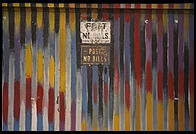
There are pocket-sized digital cameras that function quite
nicely as point and shoot cameras, for example, the Canon S100. The advantage of the
digital camera is that the photos are available for instant sharing
via the Internet and you don't have to spend money on film or
processing. The main disadvantage of digital cameras circa 2001 is
that they depend so heavily on personal computers circa 2001. With
a film-based camera, you press the button 36 times then remove the
film and take it to a lab. For long-term archival storage, a metal
file cabinet serves nicely. With a digital camera, you need to
transfer the images to a computer and learn how to use a
high-quality printer or produce Web pages. For long-term storage
and retrieval you need to get a big hard drive, a big tape drive,
backup software, and the discipline to make backups regularly.
What if you don't use your camera regularly? Suppose that two
years ago you loaded up a film-based camera with a roll of ISO 400
film and lithium battery. You took two photos of your dog's
birthday party and put the camera on the shelf until the next
birthday whereupon you snapped four more photos. Your dog's
birthday is today. You grab the camera off the shelf and snap a few
more photos then take the roll down to the local minilab. Most
digital cameras rely on rechargeable batteries. If you tried the
same scenario with a digital camera you'd have missed two birthday
parties.
Why you might not want that fancy zoom P&S
Zoom lenses have more elements (pieces of glass) than fixed
focal-length lenses. More elements means more ways for light to
bounce around inside the lens. Stray light (flare) fills in areas
of the picture that are supposed to be black, thus reducing
contrast. That's why pictures taken with most zoom lenses are flat.
If your subject is a stand of trees on a foggy day, you might not
mind, but most of the time photographs taken with a zoom lens will
lack snap.
You can forget about shooting into the sun with most cheap zoom
lenses; all you will get is flare.
The zoom lens adds weight, cost, and size. You might not have
the camera with you when you need it and that's the whole point of
getting a P&S instead of an SLR.
-
But I want the zoom to take portraits
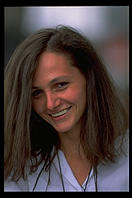
A longer focal length makes for better portraits, but you will
generally want a fast aperture (e.g., f/2.8 or f/4) to throw the
background out of focus and concentrate the viewer's attention on
the subject. A Nikon 80-200/2.8 lens ($1000) makes a beautiful
portrait lens, but the zooms on P&S cameras are usually around
f/8 or f/11 when racked out and therefore will render the Exxon
station behind your subject perfectly sharp.
The photo at right was taken on the street in Whitehorse, Yukon
(part of Travels with Samantha)
with a 300/2.8 at f/4. Whitehorse, Yukon is not such an attractive
town that you'd want it rendered perfectly sharp in the
background.
-
But I want the zoom to take artistic pictures
Most artistic pictures are taken in fairly low light (see my
technique guide). Even
with ISO 400 film, a point and shoot zoom lens is so slow at longer
focal lengths that you'll never get anything without a tripod. And
a tripod kind of spoils the whole idea, doesn't it? (Though not as
badly as on-camera flash, which spoils nearly every photo.)
A Yashica T4 with its 35/3.5 lens will let you do creative
things with ISO 400 print film and even ISO 100 slide film,
without having to turn on the flash all the time.
Why you might want that fancy zoom P&S
Technology changes fast. Some of the very latest zoom P&S
cameras can fit in a shirt pocket and don't have much flare. How do
they do this? With aspherics. Most expensive camera lenses are
still made with only glass elements that are sections of spheres.
If you are willing to mold a lens out of plastic you have much more
freedom of shape and can correct more optical problems with a
single element.
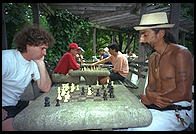
Minolta sells a 28-70mm shirt-pocket zoom camera that uses four
elements, two of them aspheric.
The exposure system is great with slide film and the contrast seems
just as good as with the T4. Under a Schneider 4X loupe, the
images
from mine were sharp enough for the photo editors at Hearst
magazines. The fill flash doesn't suit me very well on overcast
days, however. The subject is usually brighter than the background
and that looks unnatural. I'm not sure if the T4 was any better or
if I just tended to use it more with ISO 50 film where the flash
didn't have much reach.
I carried mine in my front left pants pocket for a few months
and the viewfinder filled up with dust (lint?) then the camera
jammed and prematurely rewound its 10th roll of film. This was the
same failure mode as my old T4. I sent it back to Minolta and they
cleaned it for me and claimed that it works perfectly now. It would
seem that I've demonstrated the inability of these cameras to
survive the pants pocket environment. [Note: the camera broke again
a couple of months later. I sent it back to Minolta for warranty
service. They held it for two months. It came back vaguely repaired
but still not behaving reliably.]
The Yashica T4: a sensible choice
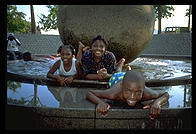
Thousands of pros have Yashica T4 point & shoots. These have
a fixed 35/3.5 lens that is as sharp and contrasty as most SLR
optics, an exposure metering system accurate enough for slide film,
and a true shirt-pocket size. Even Consumer Reports
top-rated this camera. It is about $150 in New York. The latest "T4
Super" (known as the T5 in Europe and Asia) has the same optics and
film transport but adds a right-angle "waist-level" finder (good
for low-angle and/or sneak shots) plus weatherproof construction.
The latter is very important if you like to carry your camera in a
pants pocket, where the high humidity from, dare I say it, sweat
tends to fog the viewfinder.
My T4s have proven to have exposure metering that is
sufficiently accurate for slide film though these days I never use
anything other than ISO 400 color
negative film in a point and shoot (or sometimes Kodak TMAX 400
CN black and white film, which is more or less the same idea).
Don't expect miracles from the T4, though. The plastic
construction doesn't feel any better than the other P&S
cameras; it is the beautiful Zeiss Tessar 4-element lens (with T*
coating) that makes the T4 special.
Here's something I found in the rec.photo newsgroups about a
German magazine's test of a T4 versus expensive ($600) Contax and
absurdly expensive ($900) Nikon P&S cameras (yuppie class):
"The following is a side by side comparison of Yashica
T4 vs Nikon 35Ti and Contax T2's optical performance according to
foto Magazin test charts.
Yashica T4 T2 Nikon 35Ti
Lens: Tessar 35mm/3.5 Sonnar 38/2.8 35mm/2.8
Resolution (smaller better)
Center: 0.017mm 0.015 0.015mm
Edge: 0.017 0.016 0.018
Contrast (higher better)
Center 92% 78% 72%
Edge 85% 50% 45%
Optical
Performance 9.8 9.4 9.2
Rating ***** **** ***
T2 slightly better than 35Ti, but very close.
T4's resolution < T2 at center and edge
< 35Ti at center
> 35 Ti at edge
T4 contrast, better than T2 and 35Ti center/edge
by subtantial margin."
Here are a few other cameras worth considering:
- Olympus Stylus Epic. It has a four-element 35/2.8 lens
(2/3rds of an f-stop faster than the T4), is weatherproof, and can
be triggered with an optional infrared remote control.
- Ricoh GR1.
philg@mit.edu




